
Transport Scotland has gone silent about its plans (see here) to upgrade the A82 along Loch Lomond since the Helensburgh and Distict Access Trust (HADAT) lodged a complaint with Audit Scotland about the process last summer (see here). It is good to see that HADAT is keeping up the pressure, both with its petition to the Scottish Parliament asking for an alternative route to be considered (you can sign here) and with wider publicity such as this excellent letter published in the Herald last week.
Why, one might ask, doesn’t Loch Lomond deserve to be protected every much as Killiekrankie? This post will consider the impact the proposed upgrade would have on ancient woodland and will argue that as a result of new Scottish Government policy Transport Scotland’s proposed route now needs to be changed.
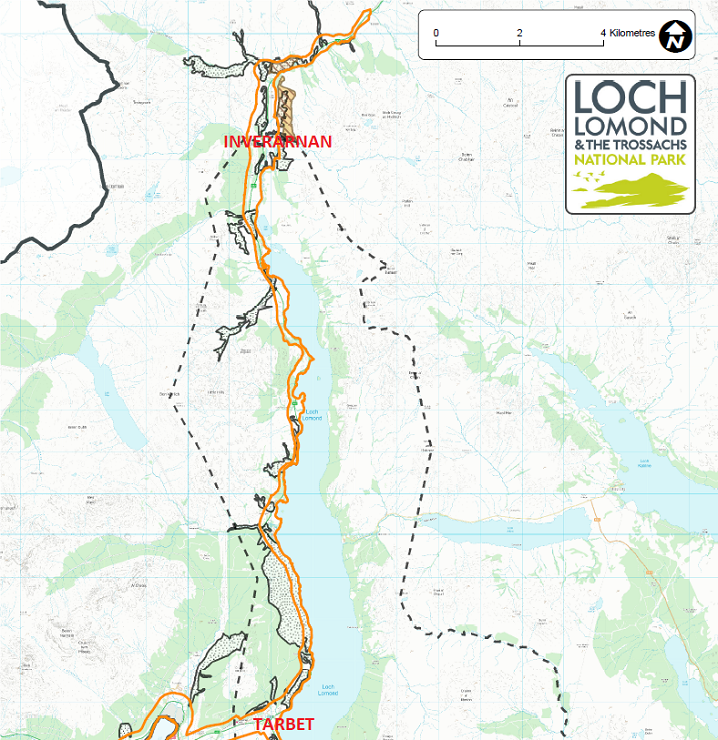
One of the reasons the Loch Lomond and Trossachs National Park Authority (LLTNPA) used ten years ago for introducing the camping byelaws was the alleged impact that campers had on ancient woodland. The presence of ancient woodland was used to justify the camping management zone along the west shore of Loch Lomond, the same corridor of trees that would be affected by Transport Scotland’s proposals to upgrade the A82 between Tarbet and Inverarnan!
The hypocrisy and double thinking of the LLTNPA in respect to protecting the west shore of Loch Lomond has been breathtaking. Four years later in their National Park Partnership Plan they committed to supporting the proposed upgrade with no reference to the impact this would have on ancient woodland, on the spurious grounds that it would enhance opportunities by the public to enjoy the landscape!
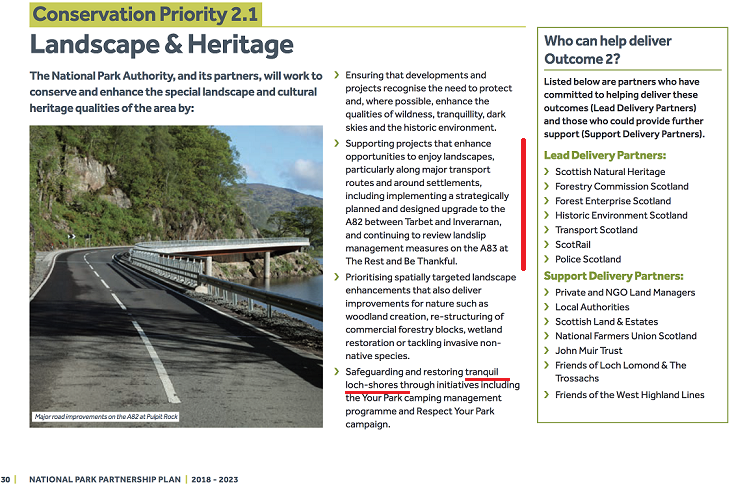
The claim that the camping management zone had served to restore tranquillity to the loch was nonsense: most of the campers along this section of shoreline were anglers who had every reason to keep quiet. But while advocating tranquillity, the LLTNPA was also supporting the construction of a faster road which would inevitably result in………… more noise!
Parskwatch has previously highlighted the LLTNPA’s failure to evaluate the impact Transport Scotland’s proposals to upgrade the A82 in terms of its statutory duties to protect the landscape etc (see here), but I had not appreciated how the LLTNPA appear to have manipulated their Trees and Woodland policy to make it easier for the proposed development to go ahead:
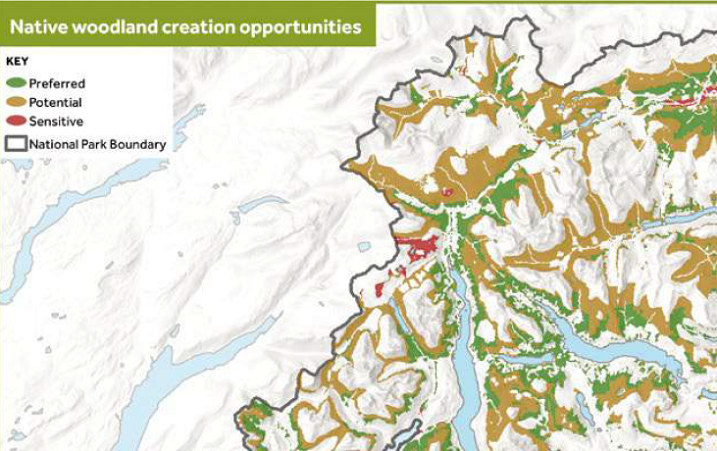
Note how the west shore of Loch Lomond has been left white, in other words this is a strip of land where the LLTNPA sees NO opportunity for creating further native woodland despite the fragmented blocks of ancient woodland along the shore shown in their map above and despite claiming the vision in their strategy would:
“Result in a strengthened native woodland habitat network across the National Park at all scales, allowing a wide range of woodland species to disperse, recolonise and migrate more easily”
The LLTNPA has also set out its vision for how it proposes to tackle the nature crisis, called “Future Nature”, which in my view is even more useless (see here). It contains just two references to woodland and not a single mention of the Atlantic Rain Forest. As is usual with the LLTNPA it contains no concrete proposals, let alone anything which would help restore the oak woods on the shores of Loch Lomond. The whole vision is meaningless spin.
National Planning Framework 4 (NPF4) to the rescue?
Happily for those concerned about the future of the National Park, many of the LLTNPA’s policy failures have now been made redundant by NPF4, policy 6 of which reads as follows:
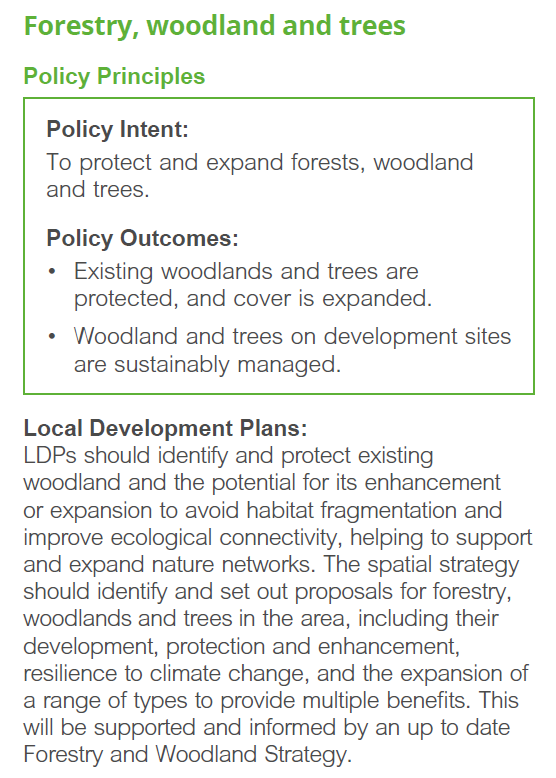
The implications of this in respect of the proposed A82 upgrade is the LLTNPA now needs to avoid endorsing any route that leads to “habitat fragmentation”. Moreover they need to revise their Trees and Woodland strategy to explain how they intend to improve the “ecological connectivity” of the ancient woodland sites along the west shore of Loch Lomond!
The actual policy, which supersedes all previous policy adopted by the LLTNPA and Transport Scotland starts as follows:
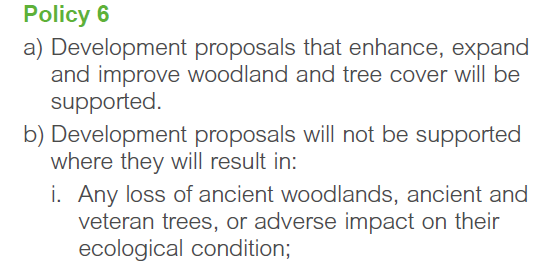
This should cause both Transport Scotland and the LLTNPA to have a major re-think about the current proposed route, which has basically been adopted because it was thought to be the cheapest option. What price nature? With the LLTNPA about to launch a consultation on its a new National Park Partnership Plan, now would be a good time for them to abandon their support for the shore route and call on both Transport Scotland and the Scottish Government to come up with alternative proposals.
It is almost six years since the then Transport Minister, Humza Yousaf, announced that the A82 between Tarbet and Inverarnan would be widened to 7.3m (see here). Scottish Governments since then have ramped up their rhetoric about tackling the nature and climate emergencies and now appear more prepared to put their money whether their mouth is. NPF4 has already had some impact in the Loch Lomond and Trossachs National Park, forcing Flamingo Land to amend their planning application at Balloch to exclude further areas of woodland (see here). The same principles now need to be applied to the West shore of Loch Lomond. Will the new First Minister now be prepared to admit he made a mistake and ask Scotland to develop an alternative route for the A82 for nature’s sake?
The technology has clearly existed 400 miles to the south of Loch Lomond. for many decades now. A 7.5 mtr diameter machine has drilled for 16 miles a huge pipe up to 70 mtrs below ground, below the Thames. £5 billion from structural funding has easily been found to fund this essential work …(So that London can continue to thrive).
Th Swiss and Norwegians know how to “do” environmentally sound infrastructure development too. They know this will ensure jobs for the next generation and “grow” prosperity at the same time.
What continues to be lacking in Scotland is the necessary Political willpower to commit to any fresh structural plan that might eventually take more than one Parliamentary term to deliver. Replacement of vital ferries …. completing a ” flagship policy” over dualling of the A 9.. rebuild of outdated regional hospitals.. this state of blinkered apathy, along with “patch, repair and make-do” (safeguard fat salary- first) mindset, is bound up in every aspect of governance across Scotland today. It needs to change.
My understanding is that there’s already an existing conifer plantation to the North of Tarbet. This could be observed by looking at an aerial photograph or other background map. The NP Trees and Woodland strategy disregarded any area of existing woodland for woodland creation potential for obvious reasons.
Yes, but what it didn’t do was consider where it might be desirable to remove conifers (in the medium to long term) and replace them with native woodland to improve ecological connectivity…………..
Hmm – the strategy has around 16 years left – do you realistically think that FLS would be onboard with felling an area of productive conifer before it reaches maturity and full economic value? And that the NP would have a say in that?
I was not suggesting that FLS should remove productive conifers early, that would be stupid, but what I am saying is that where FLS are harvesting conifers on ground between blocks of native woodland, including “Atlantic rain forest”, the LLTNPA should be they are replaced by native woodland (preferably through natural regeneration). There is a prime opportunity at present just north of Tarbet on Cruach Tairbeirt where FLS is harvesting many of the conifers and plenty of other opportunities in the area, eg FLS are currently harvesting larch early around Ardgarten in a (vain) attempt to prevent the spread of Phytophthera Ramorum